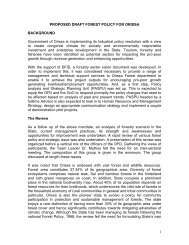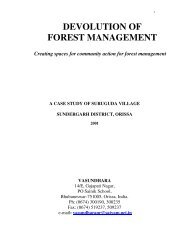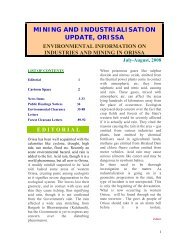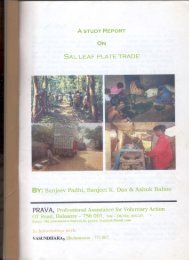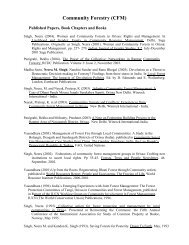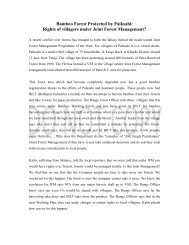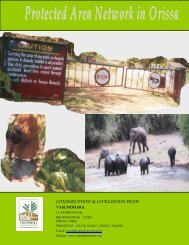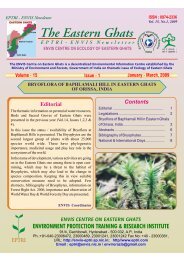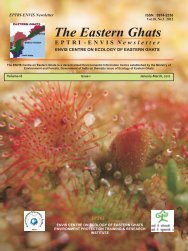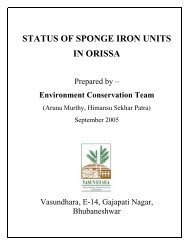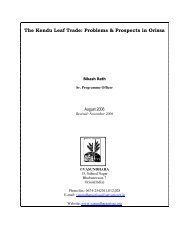Bamboo in Orissa: Trade and Livelihood Perspective - Vasundhara
Bamboo in Orissa: Trade and Livelihood Perspective - Vasundhara
Bamboo in Orissa: Trade and Livelihood Perspective - Vasundhara
You also want an ePaper? Increase the reach of your titles
YUMPU automatically turns print PDFs into web optimized ePapers that Google loves.
All rights reserved by VASUNDHARA(www.vasundharaorissa.org). For any clarification, contact author at sunlit1968@yahoo.co.<strong>in</strong><br />
process with the help of a knife. After thorns are removed, the culms are sundried(for 3-4<br />
days <strong>in</strong> summer <strong>and</strong> 10-12 days <strong>in</strong> w<strong>in</strong>ter) first <strong>and</strong> then seasoned <strong>in</strong> water for 4-5 hours.<br />
The uppermost layer is removed with the help of a sharp knife before f<strong>in</strong>al use. After that<br />
strips are extracted from the culms. For mak<strong>in</strong>g frames, bend<strong>in</strong>g of culms is required for<br />
which such pieces, coated with oil, are exposed to heat treatment over a blue-lamp.<br />
Colour<strong>in</strong>g is not frequent <strong>and</strong> reaction with water imparts a reddish t<strong>in</strong>t to cane. Still,<br />
artificial colour<strong>in</strong>g can be done by treat<strong>in</strong>g the canes with coloured solutions.<br />
As <strong>in</strong>dicated earlier, cane work takes more time <strong>and</strong> labour than bamboo work(artistic). If a<br />
bamboo jhudi takes 4 hours for production, a beta jhudi of same size would take about 12<br />
hours for the same. The cost of raw material also varies significantly; Rs.10 <strong>in</strong> case of the<br />
former <strong>and</strong> Rs.80-110 <strong>in</strong> case of the latter. Hence the bamboo jhudi is sold @Rs.40/piece<br />
whereas its beta counterpart is priced at Rs.220.<br />
For a gauni priced at Rs.150/piece, the cost of raw material is about Rs.50, <strong>and</strong> 1.5<br />
m<strong>and</strong>ays are required for its production.<br />
As regards furnitures, a cane sofa set(4 s<strong>in</strong>gle chairs with double-h<strong>and</strong>le <strong>and</strong> one tea-poi)<br />
which is to be sold at about Rs.2500, requires raw material worth approx. Rs.1600 <strong>and</strong><br />
labour worth Rs.350(4.5 m<strong>and</strong>ays), besides transportation(to the nearest town) cost of<br />
Rs.70 (per comm., Sailabala Moharana <strong>and</strong> Panchanan Moharana). Cane purchased from<br />
Kolkata shares about 75% of the raw material cost, those purchased locally share only<br />
about 16% of the same; hence the cost of production could have been reduced significantly<br />
had the cane of required quality been available locally.<br />
Beta is more resistant to <strong>in</strong>sect-attack(like white ants) than bamboo <strong>and</strong> other substitutes<br />
provided it is properly sundried <strong>and</strong> seasoned before use. Culms of 1-year age or more are<br />
used, <strong>and</strong> unlike bamboo dried & seasoned culms can be stored for one year or more<br />
without los<strong>in</strong>g their quality <strong>and</strong> workability.<br />
The durability also depends on whether the upper(external) part(pithi) is used or the <strong>in</strong>ner<br />
part(anti), because as <strong>in</strong> case of bamboo, products made of the upper part are more<br />
durable(flexible) <strong>and</strong> are hence costlier than those made of the <strong>in</strong>ner part. It may be noted<br />
<strong>in</strong> this context that the production of pithi cane is almost 90% less than that of the anti part<br />
<strong>in</strong> any culm.<br />
Products of kia canes(strips) look similar to beta products(exclud<strong>in</strong>g furnitures). In fact, the<br />
look is so similar that some artisans sell them as beta products. The clue to their dist<strong>in</strong>ction<br />
lies <strong>in</strong> the fact that if immerged <strong>in</strong> water, beta basket would assume a reddish colour<br />
whereas kia basket would rema<strong>in</strong> white for sometime <strong>and</strong> would then turn blackish.<br />
Process<strong>in</strong>g kia is quite easier than cane <strong>and</strong> the basket which would take 1.5 to 2 m<strong>and</strong>ays<br />
for mak<strong>in</strong>g <strong>in</strong> case of kia, would take 3 m<strong>and</strong>ays <strong>in</strong> case of cane. While kia is locally<br />
collected from wastel<strong>and</strong>s free of cost, cane is often purchased. The sale price thus varies<br />
accord<strong>in</strong>gly, like Rs.80-100 <strong>in</strong> case of former <strong>and</strong> Rs.220-230 <strong>in</strong> case of the latter.<br />
Nalia is another substitute for beta, but less durable than the latter <strong>and</strong> hence cheaper.<br />
97



